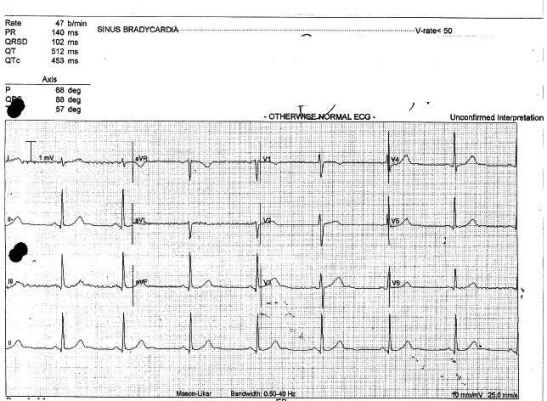- Clinical Technology
- Adult Immunization
- Hepatology
- Pediatric Immunization
- Screening
- Psychiatry
- Allergy
- Women's Health
- Cardiology
- Pediatrics
- Dermatology
- Endocrinology
- Pain Management
- Gastroenterology
- Infectious Disease
- Obesity Medicine
- Rheumatology
- Nephrology
- Neurology
- Pulmonology
Organophosphate Poisoning Presenting as Syncope
Signs and symptoms of organophosphate poisoning occur through an exaggerated cholinergic or nicotinic response at the neuronal synapse.
A 50-year-old man presented to the emergency department (ED) after experiencing 2 episodes of loss of consciousness. While his wife was driving him to the ED, he became nauseated and vomited. In the ED, he was observed to clench his jaw with unresponsiveness for less than 1 minute. His vital signs were significant for bradycardia and sinus bradycardia. A prolonged QT interval was seen on electrocardiography (Figure). The physical examination was notable for decreased patellar reflexes (1+); the remainder of the examination was normal.

On further questioning, the patient reported that he had sprayed the exterior of his house for termites approximately 10 hours earlier and had lost consciousness for 10 minutes about 7 hours later. When he regained consciousness, there was no evidence of bowel or bladder incontinence. Two hours later, at work, he became diaphoretic and lost consciousness again.
The patient’s wife stated that the product he used to spray the house was Dursban Pro® and that he was not wearing protective equipment while he sprayed. This pesticide contains chlorpyrifos, a diethyl organophosphate.
On the basis of this information, the patient received 2 doses of atropine 2 mg and 1 dose of lorazepam 2 mg parenterally, and a pralidoxime infusion was started in the ED. He was admitted to the ICU, where pralidoxime therapy was continued and he was monitored closely.
During the patient’s admission, he did not require additional doses of atropine or benzodiazepines. His lungs remained clear to auscultation. His heart rate vacillated between normal and intermittent bradycardia. The pralidoxime was discontinued 24 hours after he received the last dose of atropine. An echocardiogram was completed to assess for cardiac dysfunction; the findings were reported as normal. The patient was discharged on hospital day 2. The pralidoxime infusion had been discontinued 12 hours before discharge. He experienced no further syncopal episodes or other persistent symptoms related to the insecticide.
Discussion
Organophosphates inhibit the enzyme acetylcholinesterase at the neuronal synapse. Poisoning may occur via ingestion, inhalation, or a cutaneous route. Organophophate poisoning has significantly declined over the past 20 years in the United States, with 8000 reported cases resulting in 15 deaths in 2008.1
Signs and symptoms of organophosphate poisoning, which occur through an exaggerated cholinergic or nicotinic response, are well documented. Cholinergic symptoms, associated with the parasympathetic nervous system, include excess salivation, lacrimation, urination, diarrhea, emesis, bronchorrhea, bronchoconstriction, and bradycardia.2-4 Nicotinic symptoms potentiated at the neuromuscular synapse range from muscle fasciculation to paralysis.2-4 CNS signs of acute poisoning include seizures, agitation, diminished mental status, and coma.3,4
The differential diagnosis for organophosphate toxicity can include electrolyte abnormalities, hypoglycemia, thyroid storm, serotonergic syndrome, and toxicities from over-the-counter medicines such as diphenhydramine or dextromethorphan. The diagnosis of organophosphate poisoning is made on the basis of clinical findings. Red blood cell acetylcholinesterase activity can be assessed to determine the degree of toxicity; however, this assay is not readily available in most hospitals.
Our patient presented in the typical time frame of cutaneous exposure. Unique to this case was his initial complaint of syncope. There are no documented cases in which syncope is an initial presentation of organophosphate poisoning.
One plausible explanation would be the patient’s sinus bradycardia with prolonged QT interval. A prolonged QT interval indicates a delay in ventricular repolarization and can predispose the individual to reentrant arrhythmias and sudden death. Several cases have noted sinus bradycardia with prolonged QT interval resulting from severe organophosphate poisoning.5,6 If other symptoms of organophosphate poisoning are absent, this is not likely to be the primary explanation for syncope.
Treatment should be initiated as soon as an exposure to organophosphates is ascertained. If cutaneous exposure is noted, decontamination with removal of clothing and rinse down should be executed.2-4
Patients who are hypoxemic on presentation should be provided with supplemental oxygen. Atropine is administered for moderate to severe toxicity to alleviate pulmonary symptoms (bronchoconstriction and respiratory secretions).
Should a patient present with neuromuscular dysfunction, pralidoxime should be administered because atropine has no effect on the nicotinic receptors.7 Pralidoxime, however, should be administered in conjunction with atropine.6 Benzodiazepines should be given to patients who present with seizure activity after organophosphate exposure.3,7
References
1. 2008 Annual Report of the American Association of Poison Control Centers` National Poison Data System (NPDS): 26th Annual Report. Clin Toxicol. 2009;47:911-1084.
2. Singh S, Sharma N. Neurological syndromes following organophosphate poisoning. Neurol India. 2000;48:308-313.
3. Rusyniak DE, Nanagas KA. Organophosphate poisoning. Semin Neurol. 2004;24:197-204.
4. Singh G, Khurana D. Neurology of acute organophosphate poisoning. Neurol India. 2009;57:119-125.
5. Karki P, Ansari JA, Bhandary S, Koirala S. Cardiac and electrocardiographical manifestations of acute organophosphate poisoning. Singapore Med J. 2004;45:385-389.
6. Liu SH, Lin JL, Weng CH, et al. Heart rate corrected QT interval helps predict mortality after intentional organophosphate poisoning. PLoS One. 2012;7:e36576.
7. Eddleston M, Singh S, Buckley N. Organophosphorus poisoning (acute). Clin Evid. March 2007:2102.
